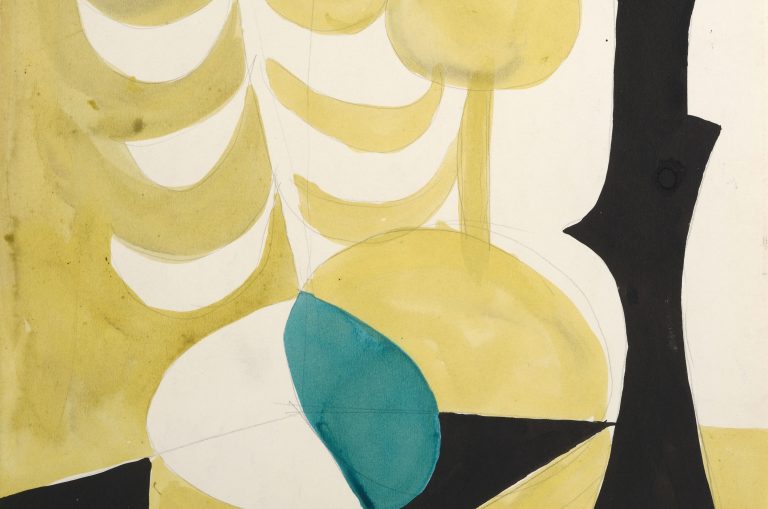Árpád Szenes grew up in a privileged intellectual milieu and entered, in 1918, into the Free Academy of Budapest. After a first exhibition in 1922 at the Musée Max Ernst, Szenes travelled in Europe, then moved to Paris where he frequented the Académie de la Grande Chaumière. It was there that he met Maria Helena Vieira da Silva. He also frequented the “Studio 17” directed by Stanley W. Hayter where the surrealist trend strongly influenced him. Several years later, in 1932, the couple met Jeanne Bucher, a meeting that would mark the beginning of a long collaboration.
The political situation in Hungary on the eve of World War II forced a departure and the couple chose to move to Portugal and then to Brazil between 1940 and 1947. There Szenes opened a studio where he taught painting.
Upon returning to Europe, he pursued his work on landscape and space, which inspired numerous voyages and a contemplative observation of nature. Progressively, the work of Árpád Szenes became a part of the collections of the French State and, in 1970, the Head of Museums of the Provinces of the Louvre organized a first retrospective of his work. That would be followed in 1974 by a retrospective at the Musée d’Art Moderne de la Ville de Paris organized by Jacques Lassaigne. In conjunction with that important retrospective, the gallery dedicated a major exhibition to him the same year. In 1977, the dedication was made in his country of origin, at the Magyar Nemzeti Gallery of Budapest then at the Varisi Tanacs Kiallitoterme Gallery in Pècs. Stricken by Parkinsons Disease for several years, Szenes passed away in his studio in Paris in 1985.
An artist supported by Jeanne Bucher beginning in 1939, and then, from 1949 onward, by Jean-François Jaeger, who dedicated a dozen solo exhibitions to his work, Árpád Szenes distinguished himself with his landscapes, poetic spaces, and memories of a happy world about to be born. Beaches, hills, skies without human presence yet vibrating with humanity. Uniting the visible and the invisible, making them fuse together by means of an exterior light interiorized by the creative act— such were the motivations of a man who kept voluntarily in the shadow of his wife Vieira da Silva only thanks to an excessive modesty.
In 2017, on the occasion of the 120th anniversary of Árpád Szenes‘ birth, the gallery Jeanne Bucher Jaeger present the exhibition “Plénitude aux confins de l’existant“.
The Fondation Nationale des Musées in collaboration with the Árpád Szenes – Vieira da Silva Foundation is organizing, for the first time in Morocco and on the African continent, the major exhibition Maria Helena Vieira da Silva and Árpád Szenes. Une histoire d’amour et de peinture, from October 18, 2023 to February 15, 2024, at the Mohammed VI Museum of modern and contemporary art in Rabat.
downloads
Oil on paper mounted on canvas
39 × 22,1 in
Photograph by Jean-Louis Losi
Oil on paper mounted on canvas
39,4 × 19,7 in
Photograph by Jean-Louis Losi
Oil on paper mounted on canvas
59,1 × 19,7 in
Photograph by Jean-Louis Losi
Oil on paper mounted on canvas
31,1 × 37,8 in
Photograph by Jean-Louis Losi
Oil on paper mounted on canvas
24,4 × 39,6 in
Photograph by Jean-Louis Losi
Tempera on paper
28,7 × 19,7 in
Photograph by Jean-Louis Losi
Oil on paper mounted on canvas
39 × 22,1 in
Photograph by Jean-Louis Losi
Oil on paper mounted on canvas
39,4 × 19,7 in
Photograph by Jean-Louis Losi
Oil on paper mounted on canvas
59,1 × 19,7 in
Photograph by Jean-Louis Losi
Oil on paper mounted on canvas
31,1 × 37,8 in
Photograph by Jean-Louis Losi
Oil on paper mounted on canvas
24,4 × 39,6 in
Photograph by Jean-Louis Losi
Tempera on paper
28,7 × 19,7 in
Photograph by Jean-Louis Losi
















